With a shuddering sob Helen collapsed on the ridge and
burst into tears.“I cannot take another step,”
she sobbed. “Oh, I know it’s all vanity and
pride!”
She was referring to the summit, looming in full
infuriating view an hour’s slog above us. “You go
on,” she said with quivering lip, “I’ll wait
for you here”.
“Forget it, I’m not going up without you and
frankly I’m not that bothered about the summit. And for
goodness sake stop crying. You’ll need that energy for the
descent”.
So that drew a line under our climb of Stok Kangri in
Ladakh, surely one of the Himalayas most accessible 20,000
foot peaks. The error that day was to have taken the summit
head on across the moraine from our advanced base camp,
which was set up on the wrong side of the glacier. Had we
crossed the glacier and pitched our tent on a platform
below the start of the climb, and then headed off
diagonally left across the moraine towards the
ridge… who knows?
It doesn’t matter: I repeated the mantra to myself on
the silent trek back to base camp and down the trail to
Stok village at the road head, the last stop before picking
up the jeep to Leh. Success, failure – every mountaineer
knows these are mere words, devoid of significance. The
summit is a trap cunningly laid by our ego, designed to
keep us bound to the wheel of samsara.
What’s that, you failed to summit Stok Kangri? There it
is, the very word of shame and humiliation, enslaving us to
our egos. It’s all rubbish, of course, we reassure
ourselves. What really matters is the camaraderie, the days
spent with good companions in the inspiring environment of
the high mountains. The summit is a bit of icing on the
cake. It adds nothing to the experience apart from a false
sense of prestige, derived from the Latin praestagium,
meaning illusion. The summit, in fact, is a mere
illusion.
Oh yes.
So it was that the following August found us starting
off once more from advanced base, this time camp properly
sited on the far side of the glacier, plodding manfully
across the moraine straight towards the summit ridge.
Two hours into the climb and “Oh, God,”
Helen moaned, collapsing once more on the ridge, in fact
the very same spot as the previous year. “It’s such a
long way…”
Not again, I thought with inner rage, an eye fixed on
the beckoning summit.
“All right, have a little rest. Have a drink of
water, catch your breath, count to ten – but we’ve got to
carry on because the weather is looking pretty naff.”
Bands of mist rolled up from the valley, intermittently
obscuring the snow-capped summit. It was obvious we would
have to move smartly if we were to enjoy any view at all
from the top. Helen began rummaging in her day sack and
what happened next left me gaping in stunned disbelief.
“What on earth do you think you’re doing with
that?” “It’s all right,” she smiled.
“It’ll boost my morale”. But – lipstick! We’re
nearly twenty thousand feet up in the Himalayas and
you… “There we are.” She zipped up her
sack, smacking her brightly rouged lips. “Let’s
go.”.
Helen is six feet tall and she is maddeningly unaffected
by altitude. Once suitably made-up off she marched at a
sprightly quip, unheeding of my protests about the
importance of keeping a slow and steady pace. We negotiated
the handful of slightly exposed spots on the ridge and
three and a half hours after leaving out tents we found
ourselves on the top of Stok Kangri, with just enough
sunlight left for a couple of snapshots of K-2 on the
horizon, before the mist billowed over the summit.
Jules Stewart is leading a Ladakh trek and ascent of
Stok Kangri on 17th-31st July 2004. Details are available
on 0207 2294774 or e-mail: Jjulesstewart@aol.com
Discus this article and give feedback in our online forum
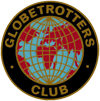
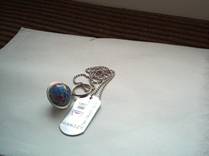 In some cache’s you may be lucky and come across a
“Travel bug”, these are small metal dog tag beetles with a number
on. If you decide to remove this from the cache you must put it in
the book. Once you get home look up the Travel bug online and see
what its mission is, some want to reach a particular destination,
others just want to visit as many places as possible. Your mission
once you have discovered what the bug wants to do is to help it on
its way by planting it in another cache, which hopefully helps it
get nearer to its goal.
In some cache’s you may be lucky and come across a
“Travel bug”, these are small metal dog tag beetles with a number
on. If you decide to remove this from the cache you must put it in
the book. Once you get home look up the Travel bug online and see
what its mission is, some want to reach a particular destination,
others just want to visit as many places as possible. Your mission
once you have discovered what the bug wants to do is to help it on
its way by planting it in another cache, which hopefully helps it
get nearer to its goal.
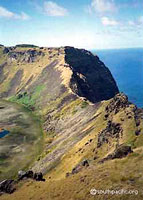 The first morning after arrival, I suggest
you climb Easter Island’s most spectacular volcano, Rano
Kau, where Orongo, a major archaeological site, sits on the
crater’s rim. But rather than marching straight up the main
road to the crater, look for the unmarked shortcut trail
off a driveway to the right just past the forestry station
south of town. It takes under two hours to cover the six km
from Hanga Roa to Orongo, but bring along a picnic lunch
and make a day of it. (If climbing a 316-meter hill sounds
daunting, you can take a taxi to the summit for around US$6
and easily walk back later in the day.) Once on top, you’ll
find hiking down into the colourful crater presents no
difficulty. It may also look easy to go right around the
crater rim, but only do so if you’re a very experienced
hiker and have a companion along as shear 250-meter cliffs
drop into the sea from the ridge.
The first morning after arrival, I suggest
you climb Easter Island’s most spectacular volcano, Rano
Kau, where Orongo, a major archaeological site, sits on the
crater’s rim. But rather than marching straight up the main
road to the crater, look for the unmarked shortcut trail
off a driveway to the right just past the forestry station
south of town. It takes under two hours to cover the six km
from Hanga Roa to Orongo, but bring along a picnic lunch
and make a day of it. (If climbing a 316-meter hill sounds
daunting, you can take a taxi to the summit for around US$6
and easily walk back later in the day.) Once on top, you’ll
find hiking down into the colourful crater presents no
difficulty. It may also look easy to go right around the
crater rim, but only do so if you’re a very experienced
hiker and have a companion along as shear 250-meter cliffs
drop into the sea from the ridge.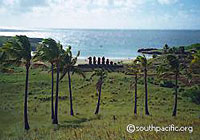
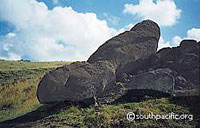 Easter Island’s moderate climate and scant
vegetation make for easy cross country hiking, and you
won’t find yourself blocked by fences and private property
signs very often. You could also tour the island by
mountain bike, available from several locations at US$10 a
day. If you surf or scuba dive, there are many
opportunities here. A minimum of five days are needed to
see the main sights of Easter Island, and two weeks would
be far better. The variety of things to see and do will
surprise you, and you’ll be blessed with some unforgettable
memories.
Easter Island’s moderate climate and scant
vegetation make for easy cross country hiking, and you
won’t find yourself blocked by fences and private property
signs very often. You could also tour the island by
mountain bike, available from several locations at US$10 a
day. If you surf or scuba dive, there are many
opportunities here. A minimum of five days are needed to
see the main sights of Easter Island, and two weeks would
be far better. The variety of things to see and do will
surprise you, and you’ll be blessed with some unforgettable
memories.